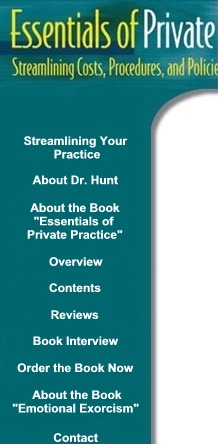 |

Book OverviewAre you planning to be or already in private practice? I decided to write this book to share some strategies that have worked for me over the years in the hopes that they will help you too. The following chapters offer practical ways to streamline your practice by increasing day-to-day efficiency and eliminating unnecessary costs. Whether you are just starting out or have been at it awhile, these steps aim to help you thrive in your business so you can do the therapy work you want as long as you choose. They have worked so well for me that I can now support myself seeing clients one to two days a week. If you find yourself in any of the following circumstances, this book may be especially appealing to you: Are you in graduate school and already dreaming about having your own practice? Are you newly-licensed and ready to be your own boss soon? Are you are already working hard in someone else’s practice that reaps a healthy profit while your compensation is much less? I’ve been there, too. After joining my first group practice when I became licensed, I realized the financial agreement would quickly lead to a diminishing return for me. Although self-employed, I still paid a tiered percentage of income to the group. Even though my percentage rose the more I made, I figured that I would be making much more if I left the group. Perhaps you are working more hours and feeling more tension in your own practice, but your take-home pay seems to be shrinking instead of growing. Count me in on this one, too. After eight months I left my first group and joined others in different expense-sharing arrangements for the next ten years. I definitely felt more pressure and less pay during these years, as managed care pushed out higher paying indemnity and PPO (preferred provider organization) insurance, panels began to close, and contracted fees were regularly slashed. More non-paid work was added, too, including treatment reports, case reviews, and special billing instructions for different managed care companies. Client stressors added to the mix, things such as no-shows, last-minute cancellations, and calls at all hours. Perhaps you have a busy practice and are ready to scale down to pursue other interests, but still need to earn enough to pay your bills. I’m right with you on this one as well. After ten years of expense sharing with others, I moved to an office by myself where I have been ever since. I decided to reduce my practice hours so I could write this book, but, I still needed to earn enough to support myself. The strategies in this book emerged from these years of different practice arrangements and assorted trials and tribulations. I pass them along to you as your colleague and ally, right beside you in the trenches of daily practice, hopefully saving you time and frustration in your own efforts. The good news is that regardless of your current circumstances, you can have the practice you want with less stress and more income. The following chapters emphasize three main strategies to achieve these practice goals: lowering overhead expenses, simplifying daily procedures, and implementing efficient client policies. These organizational and business aspects of our work can be easily overlooked, but are crucial to a successful practice. If you are in graduate school, you probably already have a good idea how to conduct therapy based on experiences in your classes, practicum, or internship. However, you may not have much familiarity with the business of private practice. Although there are many resources available that focus on the therapeutic side of our work, there are fewer devoted to setting up and operating our private practices. If you are just beginning or already have a practice, you may not know where to go for assistance in your efforts. When I was starting out, I had no business training and did not know how to set up an office or develop daily procedures and policies. It was a daunting task to blend hard business matters with the caring and therapeutic approach inherent to psychotherapy. This book aims to fill this gap and, in so doing, offer you a practice management resource. It is written directly for you, with your unique, dual status as both therapist and proprietor in mind. You will gain knowledge and skills about how to blend both of these roles, lower your strain, and increase your financial return within your daily practice. Your clients will also benefit from your increasingly well-run practice. Private practice has definitely changed over the years, with economic concerns more dominant now than ever before. If you are a new practitioner, you enter a world in which most of the insured population is covered by some form of managed care. If you are an established practitioner, you have probably experienced the reduction of therapy fees while your overhead expenses have remained constant or have increased. Many in practice have responded by increasing client loads to compensate for lowered rates. Others have added marketing efforts geared towards the self-pay population. While both of these strategies can be effective, they do require money, time, effort, and can become an increased burden to you. Consider also that when you are in need of more income, your prospective clients are likely to be struggling too. They may forgo self-pay therapy when basic expenses like mortgage, food, and clothes become a priority. This climate leads to more therapists competing for fewer and fewer cash-pay clients, creating more marketing work for you with less potential return on your time and energy investment. This book presents other alternative methods to preserve and expand your income through cutting costs and improving efficiency. Whether you market a little or a lot, whether you desire a small or large practice, these strategies can make your work easier while actually increasing take-home pay. They will allow you to see managed care clients if you choose to and still earn a good income. By retaining a base level of income in the lean times, you will add a layer of protection during any unexpected shifts in client loads. You will also boost quality care to clients, enhancing rather than detracting from the therapeutic process and outcome. As you read the chapters that follow, please note that to preserve confidentiality, I’ve changed client and practitioner names as well as identifying information. The first major streamlining strategy of reducing overhead expenses is covered in Chapters 1 through 3. Since we are often less knowledgeable about the business part of our work, we can easily lose potential profits through unchecked expenditures. You will learn ways to cut costs when arranging your practice, selecting your office, and choosing a communications system. By designing your practice with lower overhead in mind, you can ensure savings and increased earnings independent of your client load. The second major strategy of this book involves streamlining routine procedures. Many clinicians in practice lose time, energy, and income through disorganized daily operations. Chapters 4 through 6 will help you simplify daily procedures to prevent these drains. You will learn how to efficiently arrange for initial appointments, verify insurance benefits, bill insurance carriers, and get paid quickly. These suggestions will help maximize your pay with minimal effort, allowing you to provide higher quality care to clients. Although my recommendations have you in mind as the person performing these daily operations, if you decide to have someone else do any of these services, you can also adapt this information to use in training your support staff. The third major strategy involves implementing efficient client policies. Most of us enter this field with a primary desire to offer therapeutic services. We are typically sensitive, empathic, and intuitive, with much to offer as healers. These very qualities also make us vulnerable to exhaustion from the rigorous emotional needs of our clients. Chapters 7 through 9 will guide you in preserving your therapeutic gifts by establishing firm and caring policies--policies that will help both your clients and you at the same time. You will learn how to manage your finances wisely and efficiently collect the client fees you earn. You will read how to create and implement a successful cancellation policy to minimize violations and preserve your income if they do occur. You will also learn effective phone practices and policies to enhance client treatment and ensure payment for services you provide. The strategies and skills you will learn in this book will work regardless of changes in insurance policies, the economy, or other unforeseen circumstances, enabling you to survive and thrive in practice. I experienced this directly soon after beginning my own practice in 1990. I had no idea then that the insurance industry was poised for a drastic overhaul. The next several years became a whirlwind of managed care takeovers, fee reductions, micromanagement, and bankruptcies. These and many other unexpected changes threatened my practice over the years, but I prevailed by using many of the strategies that I now offer here. Whether you desire a full- or part-time practice, they will also help you to thrive, even when the most unexpected occurs. |
 |
|
Copyright 2004-2018 Holly A. Hunt |
Copyright 2004-2018 Holly A. Hunt | Copyright 2004-2018 Holly A. Hunt |